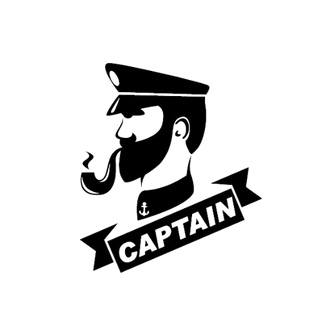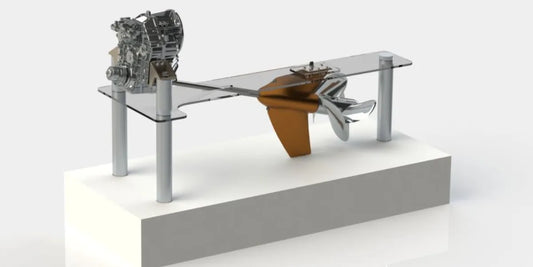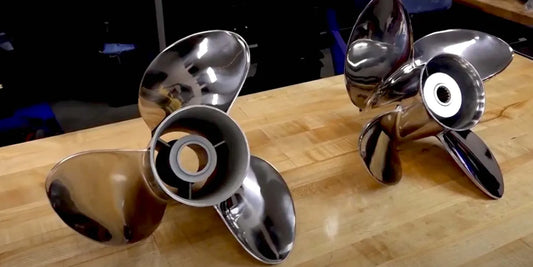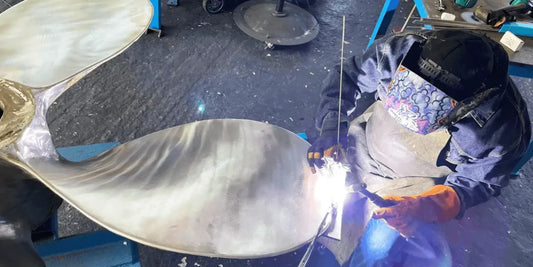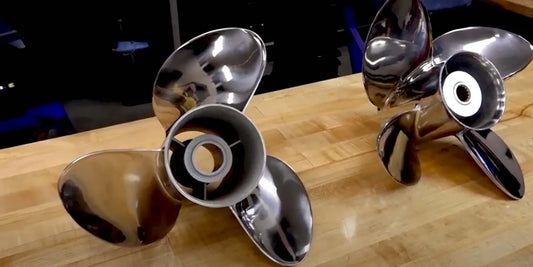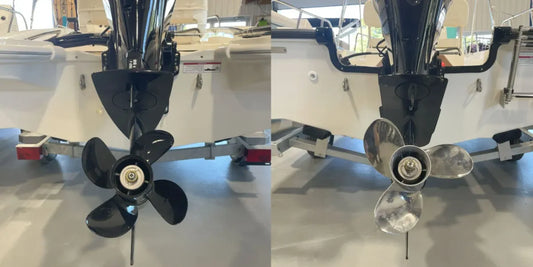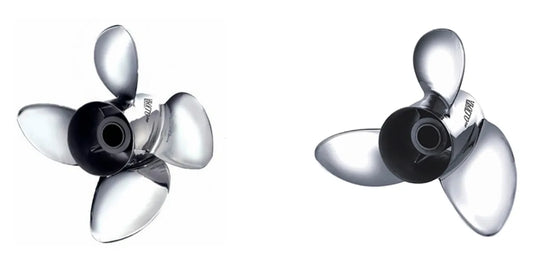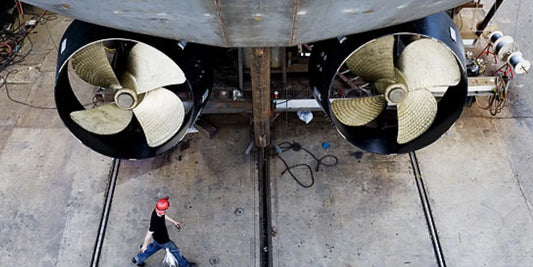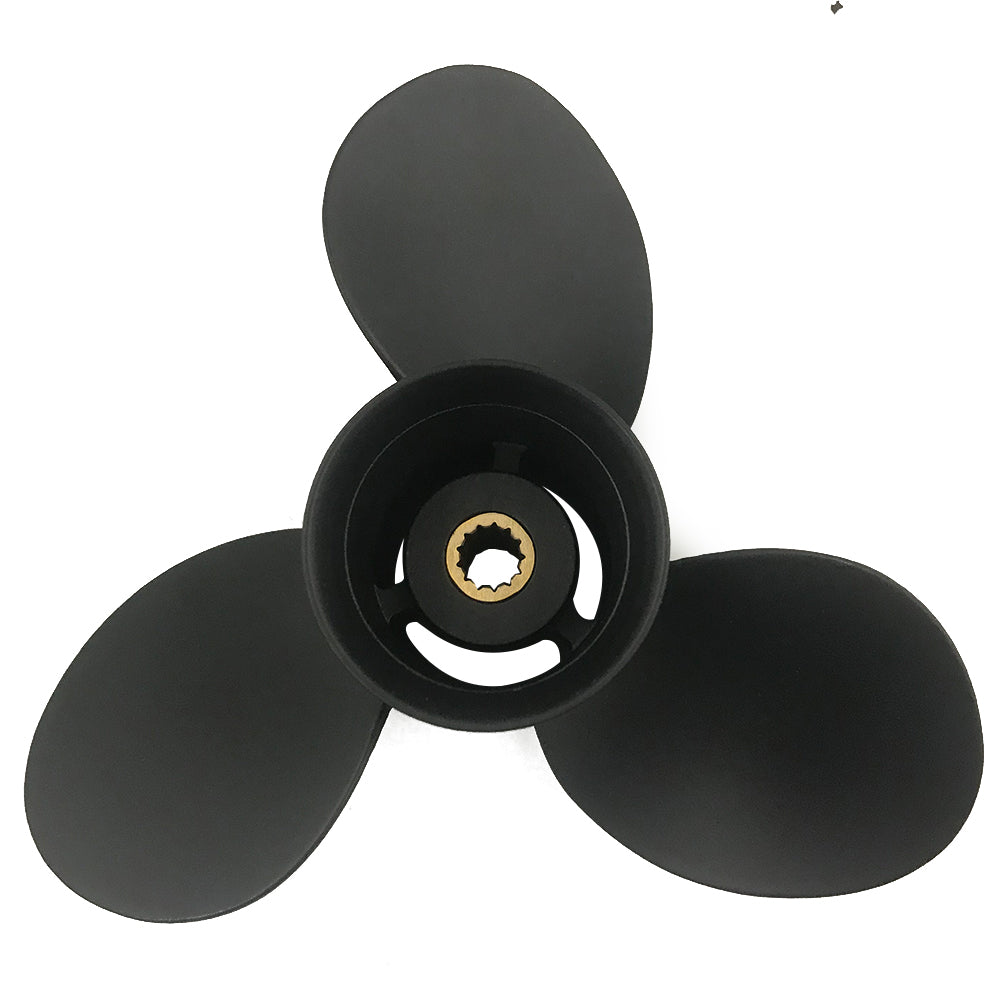Selecting the correct propeller for a Yamaha F25 outboard engine is crucial for maximizing its performance on the water. A good prop will enhance the boat’s performance to some extent, speeding it up, increasing fuel efficiency, and improving handling; hence, a wrong prop will make a considerable difference. The choice is easy when one has options on materials, pitches, and diameters. The guide aims to simplify this choice by focusing on the key considerations you need to make and how to select a prop that complements your use. We also give you tips on getting the most from your Yamaha F25. The information herein will allow every serious or recreational boater to make an informed decision to maximize the performance whenever the throttle is applied in any case.
Understanding Yamaha F25 Propellers

What is a Yamaha F25 Prop?
A Yamaha F25 propeller is a custom design specially crafted for an essential role in the operation of Yamaha's F25 outboard. Appreciated for its flexibility, fuel efficiency, and reliable performance, the F25 lightweight outboard serves varied boating purposes-from fishing expeditions to vacation cruises. It is in the propeller that the most crucial power-flow conversion of the engine into movement occurs, thus efficiently propelling the boat through the water. Choosing the perfect prop for your Yamaha F25 can notably increase its power, acceleration, speed, or fuel economy, depending on which performance period you want.
The critical elements to consider when choosing a Yamaha F25 propeller for your boat are diameter, pitch, and material. Diameter and pitch describe how fast a propeller spins relative to the thrust generated. Regarding material, stainless steel ones usually offer more performance and durability when compared to others made of aluminum; however, they come at a higher price. Besides, the number of blades on the prop and its usage conditions, e.g., flat lakes or ocean waves, will significantly affect the actual output and efficiency that your engine can provide.
Investing in the right prop will ensure the longevity of your Yamaha F25 motor. Incorrectly sized ones or incompatible propellers steadily stress your motor, reduce fuel efficiency, and lead to time-consuming mechanical failures. The right prop smooths the engine further, providing adaptability to various conditions while delivering excellent safety and enhancing your enjoyment on the water. Always follow the manufacturer's specifications or consult a marine expert when selecting a propeller for your Yamaha F25 for long-term reliability and maximum performance.
Features of Yamaha Propellers
Durability and Build Quality: Yamaha propellers are manufactured from high-quality materials, including stainless steel and aluminum, to ensure excellent durability and resistance to corrosion. This robust build allows them to withstand the harsh marine environment and last on long nights.
Precision Engineering for Efficiency: Yamaha manufacturers utilize state-of-the-art engineering techniques to produce propellers with an optimized blade design that reduces drag and enhances thrust, resulting in improved fuel efficiency and enhanced overall boat performance across various applications.
Versatility in Different Models: Yamaha propellers are available in a wide range of configurations, designed to support various types of boats and engine sizes. Whatever you have--a fishing boat, pontoon, or high-performance speedboat--Yamaha has something out there that is power- and speed-specific to meet your requirements.
Innovations Take Performance to Another Level: Some Yamaha propellers feature the Shift Dampener System (SDS), which reduces noise and vibration during shifting. Yamaha designs its propellers for smooth acceleration and steady cruising in rough water conditions.
High-Precision Manufacturing Standards: Yamaha propellers undergo rigorous testing and stringent quality control management. Each of its products is designed to meet the most rigorous manufacturing standards, ensuring consistent performance and reliability across all models.
Flexible with Pitch Options: Yamaha propellers are available in various pitches, allowing you to fine-tune the performance of your engine. The pitch chosen will give you control over speed and engine RPM, as well as acceleration and handling.
Sustainability: Yamaha has consistently prioritized environmental responsibility in designing its propellers for more efficient propulsion systems, thereby minimizing the fuel consumption of its boats and decreasing the carbon footprint of its boating activities.
A Yamaha prop guarantees you the best performance and the best solution for your specific boating applications. Yamaha propellers are a reliable choice for marine enthusiasts and professionals alike, thanks to the company's strong commitment to innovation and quality.
Types of Propellers: Stainless vs. Aluminum
When choosing between a stainless steel and an aluminum propeller, it is essential to understand their performance characteristics and advantages to fully enjoy your boat. Due to their lightweight nature and low cost, aluminum propellers enjoy considerable popularity. Furthermore, their general availability makes them an ideal investment for recreational boaters and occasional medium-engine operators. They perform well in less demanding conditions but are easily prone to damage in the worst environments, such as when thrown into rocky waters or waters laden with debris.
Stainless steel propellers, on the other hand, are famed for their durability, precision, and performance in demanding environments. Made of the most rigid material, they resist deformation and damage in almost all situations, including at increased speeds or in hostile environments. Although they carry a premium price tag compared to aluminum, stainless steel propellers offer a long-term return, well worth considering, with fuel savings, increased speed, and better handling.
According to the industry, a stainless steel propeller results in a 5% performance increase for a boat due to its efficient transmission of engine power. Additionally, it has been estimated that aluminum propellers weigh 30% less than their stainless steel counterparts, which contributes to easier handling and installation.
So, your requirements will dictate the decision: whether you want to spend less money and maintain simplicity for relatively easy use, or opt for the performers and build for the more demanding marine life.
Choosing the Right Prop for Your Yamaha F25

Factors To Consider: Horsepower and Gearcase Compatibility
When selecting the ideal propeller for your Yamaha F25, it is essential to understand the horsepower and gearcase specifications of your engine. Operating within a specific horsepower range, Yamaha F25 propellers ensure efficient performance and improved gas mileage when selected within these parameters. Furthermore, gearcase compatibility is essential, as the size, pitch, and design of the propeller must match the dimensions of the gearcase to prevent cavitation and achieve maximum thrust.
For example, a low-pitch propeller would be more favorable for holding a heavy load or providing better acceleration. With lighter boats, a high-pitch one is excellent for the highest speed. Always ensure that the propeller's hub is seated correctly within the gearcase to avoid possible damage or power loss during operation. By syncing your Yamaha F25’s specifications with an appropriate prop design, you enhance marine performance and longevity.
Pitch and Cup: Effects on Performance
The pitch and cup are two key features that affect a propeller's performance and the overall effectiveness of your Yamaha F25. The pitch of the propeller signifies the theoretical distance the prop would travel in the direction of its shaft in one complete rotation without any slippage. A lower pitch allows the engine to reach higher RPMs in a shorter time, making it more suitable for towing or carrying heavy loads. On the contrary, a higher pitch is ideal for achieving greater top speed since it moves more water with every turn.
On another note, cup refers to the very slight curvature present on the trailing edge of the propeller blades. It helps create biting action and also reduces propeller ventilation, especially when turning aggressively or in rough water. Hence, a higher cup usually means increased holding power, which is well-suited for applications requiring sharper turns or when working in rough water.
Data shows that even slight differences in pitch and cup have distinct performance changes: for example, more cup might lower speed slightly but improve efficiency and fuel economy for long-distance cruising. Similarly, a low pitch might be suitable for quick acceleration but could result in increased fuel consumption at wide-open throttle. Matching these parameters with your Yamaha F25's intended use will yield the best speed, handling, and fuel economy to suit your specific needs on the water.
3-Blade Vs 4-Blade: What Works Best For Your Boat?
When considering a choice between 3- and 4-blade propellers for your boat, being familiar with the differences in characteristics and performance of each is crucial. Typically, 3-blade props offer higher top speed and improved fuel efficiency at cruising speeds, and are therefore primarily used in applications where speed is paramount, such as water skiing or wakeboarding. Less drag means better handling characteristics and quicker acceleration.
The 4-blade propellers, however, give you much better low-speed thrust. That makes them a good choice for heavier boats and those operating frequently in choppy waters, as they provide better grip and stability. It also results in fewer vibrations than the 3-blade propellers, hence a quieter ride, which in turn improves comfort on the boat. They will, however, experience a slight decrease in top-end speed compared to their 3-blade counterparts. Nevertheless, their merit lies in their improved fuel efficiency and low-speed performance in intermediate operations, as they outperform 3-blade propellers in slow trolling and maneuvering.
The choice is mainly dependent upon the unique use of your boat, hull design, and expected performance. Examples include: 3-blade propellers will be preferable if there is a greater emphasis on high-speed cruising or recreational ventures. On the other hand, the 4-blades may have more practical applications in towing, low-speed maneuverability, and operating larger vessels. Evaluate your specific needs and ask experienced users for their feedback regarding the propeller that will enhance the YAMAHA F25's performance and suit your unique needs.
Upgrading to a Stainless Steel Propeller

Benefits of Changing to Stainless Steel
Switching to a stainless steel propeller offers numerous benefits for those seeking enhanced performance and durability from the Yamaha F25. Stainless steel propellers are significantly stronger than their aluminum counterparts, allowing for thinner blades that reduce drag and enhance efficiency. This strength translates into acceleration, top speed, and fuel economy. Stainless steel also stands up well against corrosion and is the preferred choice for saltwater boaters or those who go out under trying conditions.
The other selling point is longevity. Though stainless steel propellers might cost you more at the outset, the payoff is that they last longer and don't have to be replaced nearly as often, so they are more economical from a long-term perspective. This also means that hydrodynamic efficiency is optimized because a stainless steel propeller preserves the shape of the blades better than other types under high torque or stress. Thus, when performance is coupled with guaranteed reliability, an upgrade to stainless steel propellers is a bolt for giving the Yamaha F25 the power it needs.
When Is That Right Time
Several scenarios warrant consideration for upgrading the Yamaha F25 propeller to stainless steel. The harder it is to get through shallow or debris-filled waters, the more durable your YF25 will have to be. The stainless steel propellers resist bending, cracking, or damage significantly more than their aluminum counterparts in adverse environments. Furthermore, it is all about maximizing those times for high-performance applications, such as two sporting activities or speed with a powerful and finely tuned prop. That stainless steel rigidity maintains optimum blade geometry under stress, thus providing better acceleration, speed, and handling.
Another to consider is fuel efficiency. If you consistently spend a lot on fuel or struggle to maintain an efficient cruising speed, your current propeller may not be doing enough for you. This advantage essentially refers to advanced propellers with thrust and slip characteristics of stainless steel, designed to enhance the efficiency of your Yamaha F25, resulting in lower fuel expenses over time, especially on long trips, with improved engine performance as a supporting factor.
If your current setup isn't quite proper for what you're looking for in terms of handling changes or stride improvements, then this is an excellent investment to consider. Because stainless steel propellers typically come in more pitch and blade configurations than other materials, they'll give you more options to tailor to your requirements. They run smoothly and quietly, reducing both cavitation and vibration, so you'll be happier and more in control on the water. Upgrading to a stainless steel propeller can significantly boost your Yamaha F25 engine's performance and dependability, and improve your time afloat.
Famed Stainless Steel Propellers for Yamaha F25
There are numerous varieties of stainless steel propellers available on the market for Yamaha F25s that maximize performance, durability, and fuel efficiency. Some great popular ones are presented below:
Yamaha Performance Series: The Yamaha Performance Series stainless steel propellers do all the things that accelerate your lift-off and run at top-end speed. Embracing characteristics designed to reduce slip and gain grip, these pitch-perfect propellers generally run smoothly under heavy loads, making them perfect for fishing and recreational use. They have an anticorrosive finish on them that allows for long-term durability in environments both fresh and salty.
PowerTech SRA3 Propeller: One of the favorites among Yamaha F25 users, the PowerTech SRA3 provides excellent midrange efficiency and pulling power. This three-blade stainless steel propeller is designed for balanced performance, giving you powerful thrust with minimal cavitation. Its precision casting ensures long-term durability, whether you're cruising calm lakes or more challenging coastal waters.
Mercury Spitfire X7: With state-of-the-art materials and design, the Mercury Spitfire X7 propeller opens up hole-shot capabilities and top speeds for Yamaha F25 owners. Featuring high-strength stainless steel construction and a proprietary blade geometry, this choice maximizes fuel economy while providing enhanced control during cornering and acceleration.
Solas Amita 4 Propeller: The Solas Amita 4-blade stainless steel propeller is a multipurpose option for Yamaha F25 users seeking added stability and thrust. It is advantageous for heavier boats or those requiring extra grip in demanding situations. The design enables smoother operation through reduced vibration and consistent speed.
Yamaha Talon Series: Designed naturally for shallow water and heavy vegetation, the Talon Series from Yamaha champions durability and thrust. Providing pinpoint control and handling are the worthy qualities of this propeller for those who demand performance across different environments.
An investment in a stainless-steel propeller will enhance the performance of your Yamaha F25 engine and generally improve your boating experience. Opting for one of these highly demanded propellers allows you to customize your setup for improved speed, fuel efficiency, and long-lasting durability. Ensure the proper pitch and size for your needs to get the best results.
Maintenance Tips for Yamaha F25 Propellers

Inspecting Your Propeller for Damage
Careful inspections of your Yamaha F25 propeller are necessary to keep it working at peak efficiency and to ensure its proper rejection. By observing any physical damage on the blades, such as nicks, cracks, or bends, one can determine the efficiency loss and extra fuel consumption. The propeller hub should also be inspected for corrosion or wear, as such would weaken its joining with the engine.
One must also look for signs of imbalance. Minor deviations from a smooth surface cause excessive vibration and could put stress on the engine. Be on the lookout for foreign matter wrapped around the shaft, such as fishing line or vegetation, because these can lead to overheating and more damage. Getting into the habit of performing these checks will help keep the propeller in good working order while offering a seamless and unruffled boating experience.
Cleaning and Caring for Your Prop
Proper propeller maintenance involves regular cleaning and care to prevent damage and ensure optimal performance. First, remove the propeller carefully using the correct tools to avoid scratching or denting it accidentally. Inspect for any debris, such as fishing line, vegetation, or dirt, and carefully remove it with a soft brush or cloth.
For best results, clean the propeller thoroughly with a mild detergent and warm water to remove grime or salt deposits, especially if the boat operates in saltwater. The best way to do it is with a soft sponge that will not damage the finish. Once you have cleaned your propeller and dried it, check for signs of corrosion or wear, particularly along edges and blades.
Protect the lifespan of your propeller by applying a protective coating such as a marine-grade lubricant or an anti-corrosion spray to keep it safe from rust and moisture. Check the propeller hub to ensure it's well-lubricated. It is helpful to lubricate any moving parts to reduce friction when in use. Take the time to inspect your propeller regularly to check for cracks, chips, or other damage that may hamper its performance. You should then replace it if you find any significant damage.
If incorporated into your routine maintenance, this will help maintain the efficiency of the prop while avoiding expensive repairs, thus giving you full value for your prop.
When and How to Replace Your Propeller
Replacement is needed if you notice any significant performance inconsistencies, such as slow speed, poor fuel consumption, or vibrations during operation. Your vessel's overall function and safety will be severely compromised by a damaged or poorly performing propeller. Checking regularly will help you identify signs of wear, such as bent blades, cracks, or corrosion. If the propeller has sustained structural damage that can't be repaired, or it is performing well below standards, it is time to replace it.
First, ensure that the vessel is safely out of the water and all engines are off. Use a socket wrench to remove the propeller nut and washer. Be careful not to overextend the shaft and cause damage. Now, remove the old propeller and inspect the spline shaft for debris or damage. It should be coated with a thin layer of marine grease to ensure smooth operation and prevent corrosion. Align the new propeller with the shaft and slide it into place carefully. Then secure it with the washer and nut, tightening firmly. Test the installation by wiggling the propeller gently with your hand; it should rotate smoothly. Shop around for the best maintenance and propeller replacement at the right time to ensure maximum performance and the long life of your power system.
Performance Optimization for Yamaha F25 Outboard Motors

Speed and Fuel-Efficiency Dependency on Propeller Choice
Speed and fuel consumption are highly dependent on the right propeller for the Yamaha F25 outboard motor. When I changed propeller shapes and pitch values, I would immediately notice a change in the general performance of the frame. An overly high pitch propeller caused the motor to lag and the acceleration to drop, eventually consuming more fuel. A lower-pitch propeller would improve acceleration, provide a very smooth running experience, especially when under heavy loads, while slightly reducing top speed. The key, therefore, was to find a compromise that would give me the maximum speed while balancing it with fuel consumption.
Material and blade design became equally important. Stainless steel propellers, in my opinion, offer better durability and efficiency than aluminum ones when used under stress; however, aluminum propellers are lighter and cheaper, making them more suitable for rougher purposes. Since, through trial and error, I was able to find the correct propeller setup adapted to my use, this setup undeniably increased my cruising speeds, reduced fuel consumption, and made the whole trip experience quicker and more fulfilling from both performance and cost perspectives.
The Propeller-Matching Process for Optimum Efficiency
Matching propellers for optimum performance begins with reviewing various performance parameters for a boat, including engine RPM, top speed, and fuel efficiency. I initially attempted to operate the engine within the manufacturer's recommendations regarding the Wide Open Throttle (WOT) engine RPM. This would be a good reference point for me to determine if my current propeller is correctly matched to my boat and use needs. If the RPM was too high or too low compared to the recommendation, it was a signal that I needed to adjust the pitch of the propeller. A higher pitch would reduce engine RPM and increase the potential maximum speed. In contrast, a lower pitch would allow the engine to run at higher RPM, ultimately leading to better acceleration and the ability to carry heavier loads.
I evaluated the propeller material and the number of blades. Stainless steel, along with three blades, was my choice for the ideal combination of durability and performance in my boating activities. However, if one wants more torque or smooth operation, a four-blade propeller might be just the thing for them. Keeping the propeller maintained is essential, too. I would look for damage, such as nicks or warping, that could cause vibrations and reduce performance; I would also repair any damage as soon as possible.
With my sights set on the water, I began experimenting with various propeller setups. I observed how each affected acceleration, fuel consumption, and handling, slowly but surely converging on my ideal setup. This process required patience, but the improvements, in the end, were worthwhile. When I combined fine-tuning with custom solutions tailored to meet the full scope of my requirements, I realized ultrahigh efficiency and performance, allowing me to enjoy the water to the fullest.
Choosing the Right Propeller for Different Boat Models
Choosing the right propeller for different boat models involves understanding the performance needs and characteristics of a particular boat. In my experience, the primary consideration is what activity the ship is primarily engaged in—whether it is designed for a speed activity, such as racing, or is more geared toward hauling and stability, like fishing or cruising. Boats intended for speed typically utilize a higher-pitch propeller to achieve greater top speeds. In contrast, low-pitch propellers are better suited for towing and carrying heavier loads due to their ability to generate more thrust at lower speeds.
Apart from that, I always keep in mind the engine power, boat size, and typical weight it usually carries. Different boat-engine setups would have very different requirements. For example, a small outboard fishing boat would require a simple, lightweight, and versatile propeller that would provide easy maneuvering and good fuel efficiency. On the other hand, larger boats designed for watersports may opt for stainless steel propellers, as these are more durable and efficient under higher stress. Matching the propeller with the engine's recommended RPM range is crucial, as mismatched propellers can lead to a loss of fuel efficiency and performance.
Testing and fine-tuning are the final steps. Even after deciding on a propeller that should work based on calculations, it's essential to try it out in regular boating conditions. Acceleration, top speed, and handling are all evaluated, with potential adjustments made afterward to ensure you're getting the boat's optimal performance. By matching the propeller carefully to the boat model and use, I have discovered that performance can be enhanced alongside longevity and efficiency.
Reference Sources
-
Yamaha F25 Prop Recommendation - Microskiff Forum
Discusses propeller recommendations based on motor height and boat setup. -
Yamaha Propeller Selector
A tool to help select the proper propeller for specific boat and engine applications. -
Yamaha F25 Reproping - The Hull Truth Forum
Provides insights on pitch adjustments and their impact on performance. -
F25 Propeller Advice - Yamaha Outboard Parts Forum
Offers advice on pitch changes and their effects on RPM and performance. -
2017 Yamaha F25: Which Prop? - Tin Boats Forum
Share user experiences with different propeller types and sizes for the Yamaha F25.
Frequently Asked Questions (FAQs)
What is the best prop for a Yamaha F25?
The best prop would depend on your custom needs in terms of boating, such as the type of water conditions you encounter, the weight your boat carries, and so forth. Many claim that stainless steel props offer superior performance and greater durability compared to their aluminum counterparts. Three-blade propellers may provide a fair compromise between speed and thrust, whereas four-blade ones might offer improvements in acceleration and handling capabilities. It is essential to consider the pitch: the lower will give you a better hole shot, while the higher will provide you with better top speed. After all, a personal test will reveal what works best for your particular setup.
How do I select the right pitch for my Yamaha F25 prop?
The pitch on your Yamaha F25 prop should be selected based on your knowledge of how pitch affects performance. A higher pitch yields higher top speeds but hinders acceleration; conversely, a lower pitch benefits acceleration but diminishes top speed. The weight of your boat under load conditions will greatly influence pitch selection. Nevertheless, the kind of water in which you'll be operating also matters-whether you do in freshwater or saltwater. For the best possible pitch for your application, you should probably talk to a marine professional or stick with the seat of Yamaha.
Can I use a different brand of prop on my Yamaha F25?
Yes, other brands of props are compatible with the Yamaha F25, but it all depends on the specific model. Ensure the prop fits the Yamaha F25 shaft and hub specifications. Many aftermarket props are designed to fit Yamaha engines; however, variations in performance may result from these alterations. Consider the materials, design, and actual pitch, as these factors all affect the performance of your engine. Always check propeller reviews and speak with other boaters or professionals who are knowledgeable about using different brands to make the best decision.
What are the advantages of using a stainless steel prop on the Yamaha F25?
The advantages of benefiting from stainless steel propellers for the Yamaha F25 are numerous. It will typically make it stronger than its aluminum counterpart. A stainless steel prop will increase maximum speed and top acceleration, as it allows for a better blade design due to its rigidity. They would also allow for better acceleration and handling in rough water, which otherwise is not supported by aluminum. So the upfront price favoring aluminum is well worth it!
